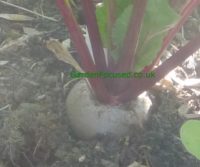The only other care needed is to thin out the seedlings to avoid overcrowding. This is best done in two goes with the first thinning occurring when the seedlings have grown to about 1½cm / ½in tall. With beetroot seed each “seed pod” may actually three or four seeds and therefore two or thee seedlings are quite likely to emerge from each “seed pod”. Thin the seedlings to 2cm (¾in) apart.
The timing of the second thinning is rather variable. We thin our beetroot for the second time when the plants are about 8cm / 3in high because at this stage the thinned plants will have micro beetroot roots which are deliciously sweet to eat. Whenever you thin them, leave the remaining beetroot 10cm / 4in apart.
WHEN TO HARVEST YOUR BEETROOT
If you want fully grown beetroot then harvest them when the root is slightly larger than a golf ball which will be some time around the fourth week of July in the UK. For the sweetest and most delicious though, harvest them a week or so before that when they are the size of a golf ball or slightly smaller.
To harvest them grip the foliage as near to the beetroot root as possible and gently tease it from the soil. Harvesting is easiest when the soil is slightly damp.
The leaves are edible and excellent for bringing colour to a salad or as a spinach alternative. The tastiest leaves are the young ones, leaves from fully grown beetroot can taste slightly bitter.
HOW TO STORE BEETROOT
Beetroot is a very popular vegetable in Eastern Europe because it can withstand a few degrees of frost when left in the ground with no damage being done. This extends the vegetable season in some cold (and relatively poor ountries) by three or four weeks.
I lived in Moscow for six months several years ago and became interested in how they preserve their root vegetables for winter consumption. After all, some of the people in countries with cold winters depend on vegetables for their very life during winter – a serious matter for them.
What I learnt is this, yes, beetroot harvested before a hard frost occurs can be stored for three or four months. In this way it can be a valuable source of food. But it never tastes anywhere near as good as beetroot harvested fresh from the ground when young and tender. If you accept that, then read on. If you want some airy, fairy stories about how beetroot can be stored in perfect condition throughout the winter then look elsewhere.
The very best way to store beetroot is to trim the top stalk to about 3cm making sure to remove any leaves. Don’t trim the root end at all. When you pull the beetroot from the ground shake off any excess earth but never wash them clean. They may look better washed but they store far better slightly muddy.
If there is any sun still remaining then lie them exposed to the sun for 12 to 24 hours. If sunshine is not available then leave them for 12 hours in a cool room. This will slightly harden the skin and prevent water
evaporation during storage.
Line the base of of a plastic box with 2cm of multipurpose compost or sand, both are fine. Only use wood boxes if you are sure that mice and other rodents won’t have access to your crop in storage. Place the beetroot in the box so they are not touching each other.
Cover the bottom layer of beetroot with 2cm of compost / sand and repeat. You may well be able to get three layers (but no more) if the box is high enough.
Store the boxes in a dark and cool but frost free place. The ideal temperature is about 34°F although this is rarely achievable in the UK. Your beetroot should remain edible in these conditions for about three months.
Don’t be under any illusions, it will not taste perfect if eaten as you would a fresh beetroot but it will still be very edible. In Russia and other neighbouring countries they get round this lack of “fresh from the ground” taste and texture by using the stored beetroots in hearty stews and soups.
Borscht is the most well known example of how to use stored beetroot to best effect. It makes a truly delicious meal and all the slightly stringy texture of stored beetroot is lost. Learn from those who depend on this food for their survival and don’t believe too much in book and website articles promising you perfect beetroot after several months storage.
COMMENTS / QUESTIONS LEFT BY OUR READERS
Sometimes our readers ask specific questions which are not covered in the main article above. Our Beetroot comment / question and answer page lists their comments,
questions and answers. At the end of that page there is also a form for you to submit any new question or comment you have.


HOW TO CARE FOR BEETROOT
When Where and How to Sow Beetroot
Ongoing Beetroot Care
Pests and Diseases of Beetroot
Recommended Beetroot Varieties
Comments, Questions and Answers
By David Marks
Beetroot are one of the easiest vegetables to care for, simply keep the area weeded and water if conditions become very dry.
When water is needed, gives lots of it infrequently rather than watering a little and often. The seeds take about two to three weeks to emerge after sowing. From sowing to harvesting as a golf ball size beetroot takes about three months.